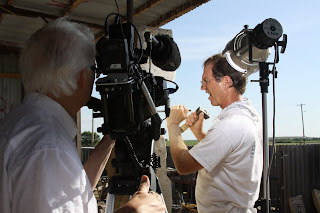Well, as I hoped, I got another opportunity to work with the well-known visual storyteller Larry Hatteberg. And this week our story was in Lucas, Kansas -- the quiet monument to several different forms of artistry. This sanctuary of creativity is peacefully snuggled in the heart of Kansas' Rolling Hills and the famous "Post Rock" country.
Larry had been in touch with an artist who was originally from California, but had come to Lucas, Kansas to sculpt faces, figures, and other designs into the limestones used as post rocks (which are limestone rocks that are used for fence posts, since they're so abundant).
Our artist was Fred Whitman of Ojai, California. He had been a dentist for several years, and it was actually in dentistry school when he first began carving and sculpting. He loved it so much, he left his practice at one point to work full-time as a sculpting artist, carving images of women, flowers, and children into stone for garden-type decor. A few years ago, he was introduced to the Kansas limestone, and loved the fluidity of the stone and how easy it was to work with it.
So, he decided, he had to come and see the Kansas limestone and "Post Rock" Country for himself. He said he came last summer and carved the images of people and sunflowers into two separate limestone post rocks.
Every day, he told us, when he was working on the projects, he would drive from Lucas a few miles south and set his "studio" up right there on the side of the highway, as he carved his artwork into the timeless stone fence posts. He said he hoped his art would last forever. And, he enjoyed the natural landscape as his workspace.
 During the 2.5 hour drive to Lucas, which is northwest of Russell, Larry and I talked about everything from storm-chasing to film and from the landmarks of Kansas to general life lessons. When we arrived in Lucas, which is a typical Rolling Hills small town, Mr. Whitman was hard at work on his latest experience with Kansas limestone.
During the 2.5 hour drive to Lucas, which is northwest of Russell, Larry and I talked about everything from storm-chasing to film and from the landmarks of Kansas to general life lessons. When we arrived in Lucas, which is a typical Rolling Hills small town, Mr. Whitman was hard at work on his latest experience with Kansas limestone.He was commissioned to sculpt an image of Sen. Bob Dole, a Russell native, which (when completed) will be displayed in the Russell Country courthouse. I could see in the sketch that it would feature his signature hair, his pearly-white smile, and his purple heart medal.
After Larry filmed him chiseling away at Bob Dole's figure in the stone, which -- like all of his art -- he was making by hand, he took us a few miles south of Lucas and showed us his the two post rock masterpieces he had carved away last summer.
If you were to simply drive by one of them, unless you knew what you were looking for and you were looking sharp, you can see the outline of a beautiful female face, with flowing hair and a decor of Kansas sunflowers framing her distinct features.
"I called it a 'she,'" Mr. Whitman said at one point, referring to the rock. "It's not an 'it' anymore."
And he was right. The carvings had a certain ebb and flow to them, just like the ebb and flow of the gliding hills they stood upon. He worked with the stone, he said, not against it. And sometimes he tried to envision what or who the stone was supposed to be -- almost as if the stone had a destiny, a shape that it was meant to become.
As Larry and I discussed later, Mr. Whitman had many wonderful things to say. I know that Larry will have a full array of amazing "sound bites" (as they are called in the industry) to choose from for the story.
My favorite soundbite that Mr. Whitman gave us was when Larry asked him about the differences between the landscapes of California and Kansas.
 Mr. Whitman said he loved the "softness" of the Kansas prairie, the way the wind moved the grasses along the plains and how it was a nice change from the jaggedness and rocky terrain of California's beaches and mountains.
Mr. Whitman said he loved the "softness" of the Kansas prairie, the way the wind moved the grasses along the plains and how it was a nice change from the jaggedness and rocky terrain of California's beaches and mountains.After saying our goodbyes, we left Mr. Whitman, Bob Dole, Lucas, and Russell County behind and turned toward the wind-mill spotted route back to Wichita.
As we drove back, I asked Larry more about his time at the station, his stories on "Hatteberg's People," and how he decided on which stories he wanted to cover.
"I like to be around people with great talent," he said, "because I feel like I can learn from them."
Well, I suppose today's story was just what Larry had envisioned then: a talented artist who had an interesting story doing visually attractive things.
But the best part of the story was Mr. Whitman's passion for his art.
"I'm always happiest whenever I'm doing this," he said as he was chipping away at Bob Dole's face.
And that was something that I think Larry, and all artists in general, would agree with.
Of course, it's work. It's hard sometimes. There are obstacles to overcome, budgets to meet, people to impress, and many more demands.
But, it's art.
It's what they both love doing, in their own respective ways.
And, that's my story of the two artists. I hope that I learned something today, because I was around two very talented people.






